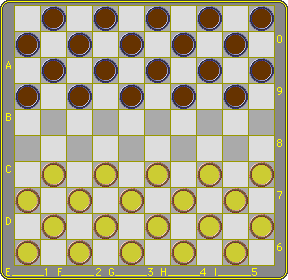 | The diagram shows the board and the pieces in initial position. There are two players, black and white. White begins. Players move - and must move - in turn. Object If a player has no legal move he loses the game. This may come about either by being eliminated or being blocked completely. Movement Capture has precedence over a non-capturing move. If the player to move has no capture to make, he has the following options:
|
A king is a promoted man. There's one exception to the above
- A player may not move (as opposed to 'capture') more than three times in succession with the same king. After three times the same king must either proceed with a capture or not move at all, in which case the player must move or capture with another one of his pieces. This restriction does not apply for a player who has only kings.
- A man moves one square diagonally forward, provided the target square is vacant. If a man ends its move on the back rank, it promotes to king. A king moves any distance of free squares along an open straight or diagonal line.
Capture
Capture is compulsory. The direction of capture may be both forward and backward in both the straight direction and the diagonal direction.
- A man captures by jumping over a (straight or diagonally) adjacent man to the square immediately beyond, which must be vacant for the capture to take place. If the man can proceed capturing pieces from this square, it must do so, taking care beforehand to take the route that brings the maximum value.
- A king captures by the long leap over a piece it can see in a straight or diagonal line, provided the square immediately beyond is vacant. If more subsequent squares are vacant it may land on any of these. If the king can proceed capturing pieces from the square it lands on, it must do so, taking care beforehand to take the route that brings the maximum value.
- A king has more value than a man, but less than two men.
- If a king and a man can capture an equal value, then the king must capture an the man may not.
- A capture must be completed before the captured pieces are taken off the board.
- In the course of a capture, the capturing piece may visit the same square more than once, but it may not capture the same piece more than once.
If a player has two kings, and his opponent has one king, then the first player has seven moves to win. If he does not succeed to win in seven moves, the game is a draw.
